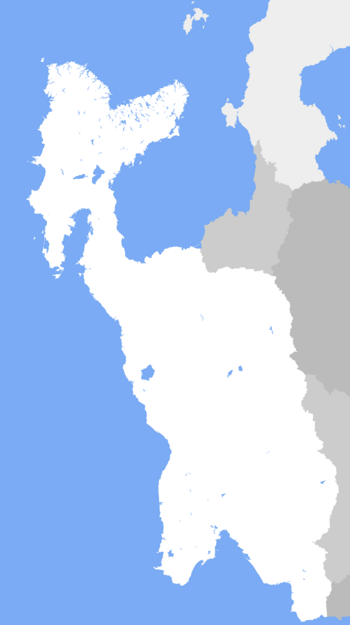Kiyortza
Republic of Kiyortza Dijavn Kijorcani (Keijasi) | |
|---|---|
|
Flag | |
 | |
| Capital | Kyrisje |
| Largest city | Loržika |
| Official languages | Keijasi Rijaki Ikari Norita Rukoči Žinasi Lorfier Ifarszi Astari |
| Ethnic groups | Several, TBA |
| Demonym(s) | Kiyortzani |
| Government | Democratic Federal Republic |
• President | Jaro Ilhasn |
| Legislature | Parliament |
| Establishment | |
• Union established | July 16, 1607 |
• Republic established | April 5, 1769 |
• Current constitution | November 1, 1893 |
| Area | |
• Total | 1,657,269 km2 (639,875 sq mi) |
| Population | |
• 2020 census | 194,416,610 |
• Density | 118.26/km2 (306.3/sq mi) |
| GDP (PPP) | 2020 estimate |
• Total | $8.917 Trillion (7.396 Trillion KJI) |
• Per capita | $45,864 (38,125 KJI) |
| GDP (nominal) | 2020 estimate |
• Total | $7.809 Trillion (6.477 Trillion KJI) |
• Per capita | $40,166 (33,388 KJI) |
| HDI (2020) | 0.911 very high |
| Currency | Kijorsi (KJI) |
| Time zone | UTC-8 (KJS) |
| Driving side | left |
| Calling code | +19 |
| Internet TLD | .kj |
Kiyortza (Keijasi: Kijorca), formally the Republic of Kiyortza, is a country in northwestern Thuadia, nestled largely between the Paisi Ocean to its west and Vaali Mountains to its east, with a handful of island possessions, including most prominently the island of Žinat and the islands of Irkylis and Nikorva. Covering an area of about 1.65 million square kilometers, it shares a land border with the nations of Astaria, Askye, Vescarium, and Fichmanistan, all to its east, while all of its remaining boundaries are dictated by sea. Kiyortza is a unitary semi-presidential republic, with its capital in Kyrisje, while its most populous city is Loržika; other major cities include Ifuksijaf, Kanistrji, Karijevo, Rykiri, Andirau, Kisomara, and Kajici, among others.
Southern Kiyortza, alongside regions of nearby Vescarium, is thought to be one of the early cradles of civilization, tracing much of its history back six to seven millenia alongside the Tanesi and Rijaga Rivers, abundant sources of water in an otherwise dry and fairly unwelcoming landscape of desert and chaparral. For several millenia, the civilizations of southern Kiyortza were the dominant power west of the Vaalis, though with the emergence of civilizations further north within the flat plains of Keivarija, the region soon became divided between north and south, separated primarily by the Fukulji Mountains. As such, until more recently, the states within Kiyortza had been undergoing a perpetual cycle of expansion, conquest, and refracturing.
By the 16th century, the borders that would define modern Kiyortza's internal and externals borders had mostly taken shape, between the Ikari conquests of Astari land, Rijaki occupation of western Ifarszia, and the creation of Keijasi Akesda; by the early 17th century, the nation of Kiyortza was formed through personal union between the Keijasi and Viškari crowns, bringing about a brief period of prosperity. By the mid-18th century, however, the rising price of basic goods due to recent conflicts and large amounts of corruption within the regime soon brought widespread discontent, and eventually led to the Kiyortzani Revolution of 1761, with the dissolution of the monarchy, and formation of the Republic of Kiyortza in 1769.
In the late 19th and early 20th centuries, Kiyortza faced several conflicts, both internal and external, after the establishment of the Kiyortzani Empire by [name TBD]. Soon after the full absorption of the puppeted southern [name TBD 2] into Kiyortza, the discontent of the public soon led to the deposition of [name TBD] in 1893, and the rewriting of its constitution, soon followed by the nation entering the Great War in 1909 due to Krenyan incursion onto the island territory of Irkylis. Afterwards, with ethnic tensions again rising between the north and south, the nation fell into a period of civil war in 1920, ending with a northern victory, and the continued unification of Kiyortza. After the conclusion of the civil war, the nation flourished, with a rapidly growing economy, great leaps in scientific advancement, and the easing of ethnic tensions throughout the nation.
While its period of rapid growth has long since passed, its economy, valued at a nominal GDP of 6.5 Trillion Kijorsi, continues to hold its sway over much of Northwestern Thuadia, while simultaneously drawing in many immigrants, dampening the impacts of an aging native population. With a large high tech sector, and a global leader in transport and semiconducter industries, Kiyortza has made many contributions to science and technology, and is known for its long history, art, and popular culture, most prominently its music, animation, and video game industries.
Etymology
The Keijasi word Kijorca, originally kijvari ša, is derived from old Kiejasi kejavali ('west of the mountains'), referring to the geographical position of Keivarija relative to the Fukulji Mountains.
History
TBA
